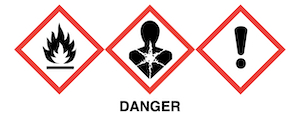CAS #: 71-43-2
UN #: 1114
EC Number: 200-753-7 |
| ACUTE HAZARDS | PREVENTION | FIRE FIGHTING |
FIRE & EXPLOSION
| Highly flammable. Vapour/air mixtures are explosive. Risk of fire and explosion. See Chemical Dangers.
| NO open flames, NO sparks and NO smoking. Closed system, ventilation, explosion-proof electrical equipment and lighting. Do NOT use compressed air for filling, discharging, or handling. Use non-sparking handtools. Prevent build-up of electrostatic charges (e.g., by grounding).
| Use foam, water spray, carbon dioxide, powder. In case of fire: keep drums, etc., cool by spraying with water.
|
| AVOID ALL CONTACT! |
| SYMPTOMS | PREVENTION | FIRST AID |
Inhalation
| Dizziness. Drowsiness. Headache. Nausea. Shortness of breath. Convulsions. Unconsciousness.
| Use ventilation, local exhaust or breathing protection.
| Fresh air, rest. Refer for medical attention.
|
Skin
| MAY BE ABSORBED! Dry skin. Redness. Pain. Further see Inhalation.
| Protective gloves. Protective clothing.
| Remove contaminated clothes. Rinse skin with plenty of water or shower. Refer for medical attention.
|
Eyes
| Redness. Pain.
| Wear face shield or eye protection in combination with breathing protection.
| First rinse with plenty of water for several minutes (remove contact lenses if easily possible), then refer for medical attention.
|
Ingestion
| Abdominal pain. Sore throat. Vomiting. Further see Inhalation.
| Do not eat, drink, or smoke during work.
| Rinse mouth. Do NOT induce vomiting. Refer for medical attention.
|
| SPILLAGE DISPOSAL | CLASSIFICATION & LABELLING |
Remove all ignition sources. Evacuate danger area! Consult an expert! Personal protection: complete protective clothing including self-contained breathing apparatus. Do NOT wash away into sewer. Do NOT let this chemical enter the environment. Collect leaking and spilled liquid in sealable containers as far as possible. Absorb remaining liquid in sand or inert absorbent. Then store and dispose of according to local regulations.
|
According to UN GHS Criteria

Highly flammable liquid and vapour
May be fatal if swallowed and enters airways
Causes skin irritation
Causes serious eye irritation
May cause genetic defects
May cause cancer
Causes damage to the bone marrow and the central nervous system through prolonged or repeated exposure
Harmful to aquatic life with long lasting effects
Transportation
UN Classification
UN Hazard Class: 3; UN Pack Group: II
|
| STORAGE |
| Fireproof. Separated from food and feedstuffs, oxidants and halogens. Store in an area without drain or sewer access |
| PACKAGING |
| Do not transport with food and feedstuffs. |
Prepared by an international group of experts on behalf of ILO and WHO, with the financial assistance of the European Commission.
© ILO and WHO 2017
|
| PHYSICAL & CHEMICAL INFORMATION |
Physical State; Appearance
COLOURLESS LIQUID WITH CHARACTERISTIC ODOUR.
Physical dangers
The vapour is heavier than air and may travel along the ground; distant ignition possible. As a result of flow, agitation, etc., electrostatic charges can be generated.
Chemical dangers
Reacts violently with oxidants, nitric acid, sulfuric acid and halogens. This generates fire and explosion hazard. Attacks plastics and rubber.
|
Formula: C6H6
Molecular mass: 78.1
Boiling point: 80°C
Melting point: 6°C
Relative density (water = 1): 0.88
Solubility in water, g/100ml at 25°C: 0.18
Vapour pressure, kPa at 20°C: 10
Relative vapour density (air = 1): 2.7
Relative density of the vapour/air-mixture at 20°C (air = 1): 1.2
Flash point: -11°C c.c.
Auto-ignition temperature: 498°C
Explosive limits, vol% in air: 1.2-8.0
Octanol/water partition coefficient as log Pow: 2.13
|
| EXPOSURE & HEALTH EFFECTS |
Routes of exposure
The substance can be absorbed into the body by inhalation, through the skin and by ingestion.
Effects of short-term exposure
The substance is irritating to the eyes, skin and respiratory tract. If this liquid is swallowed, aspiration into the lungs may result in chemical pneumonitis. The substance may cause effects on the central nervous system. This may result in lowering of consciousness. Exposure far above the OEL could cause unconsciousness and death. If swallowed the substance easily enters the airways and could result in aspiration pneumonitis.
|
Inhalation risk
A harmful contamination of the air can be reached very quickly on evaporation of this substance at 20°C.
Effects of long-term or repeated exposure
The substance defats the skin, which may cause dryness or cracking. The substance may have effects on the central nervous system and immune system. The substance may have effects on the bone marrow. This may result in anaemia. This substance is carcinogenic to humans. May cause heritable genetic damage to human germ cells. See Notes.
|
| OCCUPATIONAL EXPOSURE LIMITS |
TLV: 0.5 ppm as TWA; 2.5 ppm as STEL; (skin); A1 (confirmed human carcinogen); BEI issued.
EU-OEL: 3.25 mg/m3, 1 ppm as TWA; (skin).
MAK: carcinogen category: 1; germ cell mutagen group: 3A; skin absorption (H)
|
| ENVIRONMENT |
| The substance is toxic to aquatic organisms. The substance may cause long-term effects in the aquatic environment.
|
| NOTES |
Use of alcoholic beverages enhances the harmful effect.
Depending on the degree of exposure, periodic medical examination is suggested.
The odour warning when the exposure limit value is exceeded is insufficient.
Benzene causes acute myeloid leukaemia/acute non-lymphocytic leukaemia. Also, a positive association has been observed between exposure to benzene and acute lymphocytic leukaemia, chronic lymphocytic leukaemia, multiple myeloma, and non-Hodgkin lymphoma.
|
| ADDITIONAL INFORMATION |
EC Classification
Symbol: F, T; R: 45-46-11-36/38-48/23/24/25-65; S: 53-45; Note: E
|

